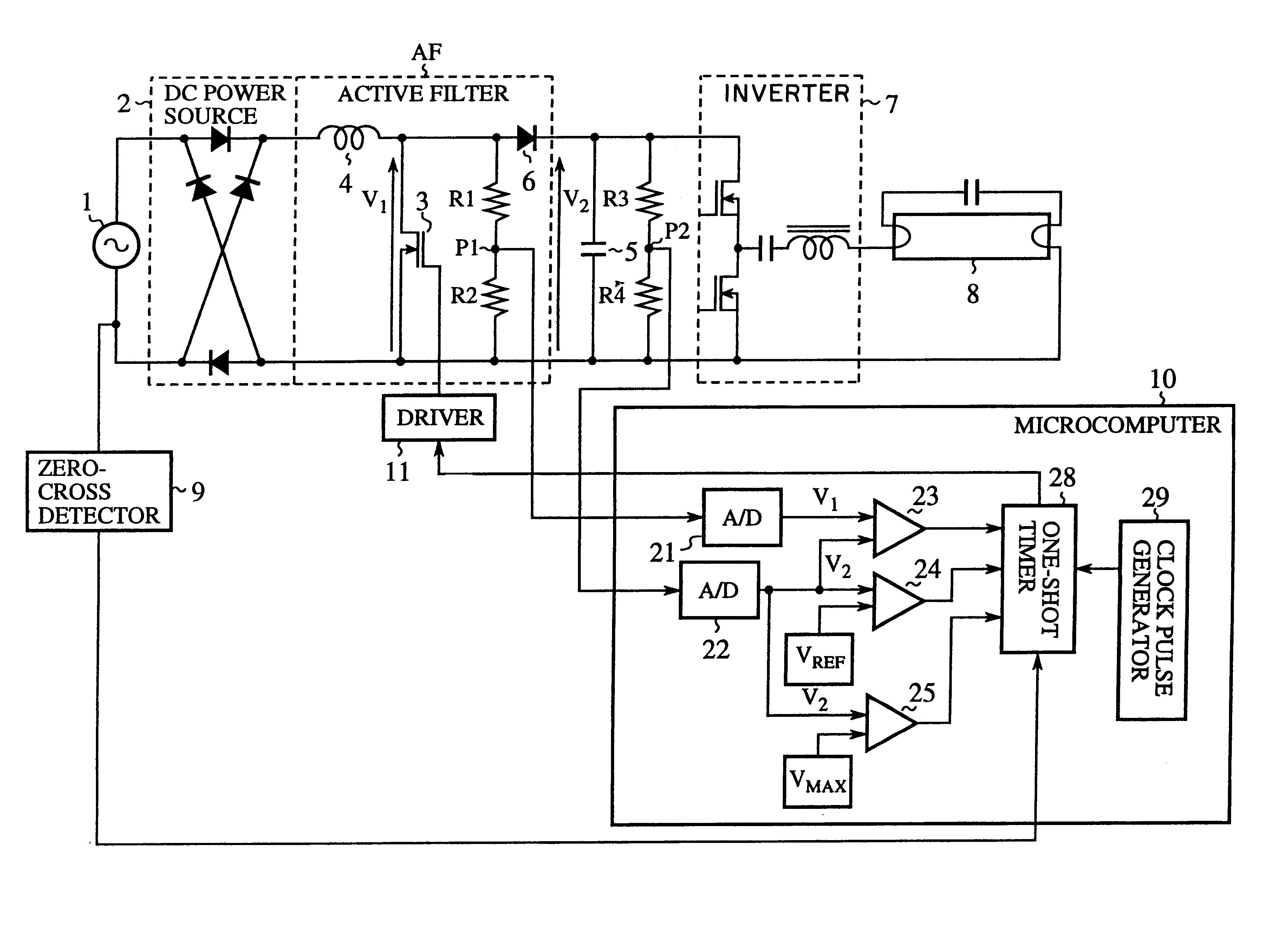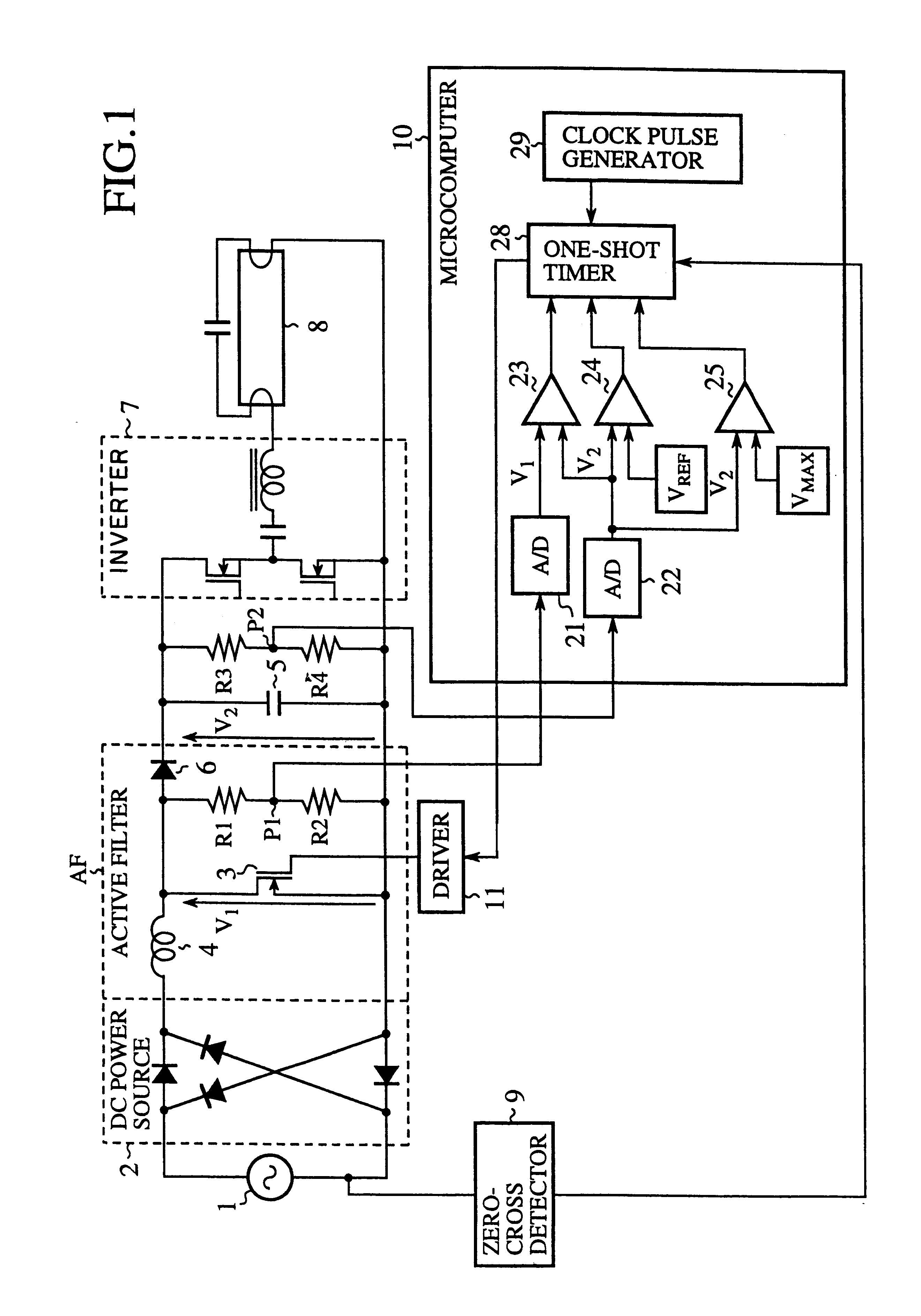Power regulator using active filter
a technology of power regulator and filter, applied in the direction of dc-ac conversion without reversal, process and machine control, instruments, etc., can solve the problems of low power factor and higher frequency noise, energy loss and harmonic noise, and the need to set the pulse period with a considerable margin
- Summary
- Abstract
- Description
- Claims
- Application Information
AI Technical Summary
Problems solved by technology
Method used
Image
Examples
embodiment 1
FIG. 1 is a circuit diagram showing an active filter control system by a microcomputer in accordance with the present invention. In FIG. 1, the reference numeral 1 designates an AC power supply; 2 designates a DC power source consisting of a full-wave rectifier; 3 designates a switching device connected in parallel with the DC power source 2 at its output side through a coil 4 of an active filter AF; 5 designates a charge-and-discharge capacitor connected in parallel with the switching device 3 through a backflow preventing diode 6; 7 designates an inverter functioning as a switching circuit for switching the charges of charge-and-discharge capacitor 5 and supplies its output to a fluorescent lamp 8; 9 designates a zero-cross detector for detecting zero-cross points of the AC current; 10 designates a microcomputer for receiving a detection signal fed from the zero-cross detector 9, 11 designates a driver for bringing the switching device 3 into conduction in response to a control si...
embodiment 2
FIG. 3 is a flowchart illustrating the operation of the present embodiment 2, in which the operation from step ST21 to step ST24 is the same as that from step ST1 to step ST4 of the foregoing embodiment 1, and hence the description thereof is omitted here. At step ST24, the comparator 23 decides whether the voltage V.sub.1 at the connecting point of the coil 4 and the backflow preventing diode 6 is lower than the voltage V.sub.2 charged in the charge-and-discharge capacitor 5, and subsequently the comparator 24 decides at step ST25 whether the voltage V.sub.2 is lower than the reference voltage V.sub.REF. If the charged voltage V.sub.2 is lower than V.sub.REF, the number of counting of the one-shot timer 28 is increased at step ST26 to broaden the pulse width.
On the other hand, if a decision is made at step ST25 that the voltage V.sub.2 is higher than V.sub.REF, the comparator 24 ensures this at step ST27, and if the result is positive (YES), the number of counting of the one-shot t...
embodiment 3
FIG. 4 is a flowchart illustrating the operation of the present embodiment 3, in which the operation from step ST31 to step ST37 is the same as that from step ST21 to step ST27 in the foregoing embodiment 2, and hence the description thereof is omitted here.
In the present embodiment 3, when a decision is made at step ST37 that the charged voltage V.sub.2 is higher than the reference voltage V.sub.REF, the comparator 25 makes a decision at step ST38 as to whether the voltage V.sub.2 exceeds the maximum reference voltage V.sub.MAX, and if the result is positive (YES), the one-shot timer 28 is controlled to stop generating the one-shot pulse at step ST40. In contrast, when the decision result is negative (NO), that is, when V.sub.2 <V.sub.MAX, the pulse width is reduce at step ST39, and the processing returns to step ST32.
According to the present embodiment 3, the charge-and-discharge capacitor 5, the voltage V.sub.2 of which can suddenly increase when the load consuming the power is r...
PUM
 Login to View More
Login to View More Abstract
Description
Claims
Application Information
 Login to View More
Login to View More - R&D
- Intellectual Property
- Life Sciences
- Materials
- Tech Scout
- Unparalleled Data Quality
- Higher Quality Content
- 60% Fewer Hallucinations
Browse by: Latest US Patents, China's latest patents, Technical Efficacy Thesaurus, Application Domain, Technology Topic, Popular Technical Reports.
© 2025 PatSnap. All rights reserved.Legal|Privacy policy|Modern Slavery Act Transparency Statement|Sitemap|About US| Contact US: help@patsnap.com



